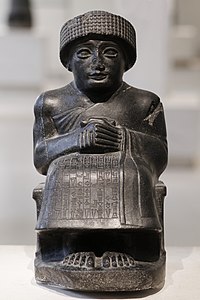Sudra (headdress)
The sudra (Aramaic: סודרא suḏārā; Hebrew: סוּדָר sudār) is a rectangular piece of cloth that has been worn as a headdress, scarf, or neckerchief in ancient Jewish tradition.
It is mentioned in various ancient and medieval Jewish and Christian religious texts in Aramaic and Koine Greek, written in or around the Near East.
[2][3][4][5] The Babylonian Talmud presents what Jastrow calls a "playful etymology" of the term as a contraction of Biblical Hebrew: ס֣וֹד יְ֭הֹוָה לִירֵאָ֑יו, romanized: sud ʾadonay lireʾāw, lit.
This piece of cloth when waved in the air also came to be used to signify applause in Rome, replacing the lappet of the toga used previously for this purpose.
[13][14] In the 5th century when the Peshitta was translated, one finds another meaning for "sudra" namely that of a burial cloth for example in John 11:44 Classical Syriac: ܘܰܐܦ݁ܰܘܗ݈ܝ ܐܰܣܺܝܪܳܢ ܒ݁ܣܽܘܕ݂ܳܪܳܐ, romanized: wa-ppaw ᵓasīrān bə-sūḏārā, lit.
[17][18] Sokoloff corroborates this broader use stating the sudra to have been a "piece of cloth [...] employed to tie and cover a variety of items" apart from a garment.
[23][24] Wajsberg identifies this mention of the sudra as a late addition to the text, being absent from earlier versions and as evidence of Jewish Palestinian Aramaic linguistic influence on the Babylonian Talmud.
'and suffocation [by means of] sudra' instead of Jewish Babylonian Aramaic: וצליבת קיסא, romanized: uṣlivaṯ qeysā, lit.
Havil's view of the sudra being a tool for torment an execution in halakhic tradition is based on numerous mentions of this use, such as the Targum Pseudo-Jonathan's translation of Exodus 21:16 (Imperial Aramaic: יתקטיל בשינוקא דסודרא, romanized: yiṯqaṭṭil bšinnuqā ḏsudrā, lit.
'he should be killed by strangulation of the sudra') as well as a section from Avodah Zarah which states, Jewish Babylonian Aramaic: רמו ליה סודרא בצואריה וקא מצערו ליה, romanized: rmu leh sudrā vṣwāreh uqā mṣaʿʿaru leh, lit.
[5][31] Berakhot 60b:5 additionally provides a prayer to be recited upon attiring the garment in this fashion Jewish Babylonian Aramaic: ברוך ... עוטר ישראל בתפארה, romanized: barukh ... ʿuṭer yiśraʾel bǝtifʾārā, lit.
The Orach Chayim section of the Shulchan Aruch, a collection of Jewish religious law from 1565, states that the Arabic name of the sudra worn this way is Imperial Aramaic: שי"ד, romanized: šid; סודר שנותנין על הצואר במלכות א"י שנקרא בערבי שי"ד וכן ביק"א שהיו נותנין בספרד על כתפיהם פטורים, lit.
[33][27][34] The 10th century commentator Rashi states: וסודר שבצוארו - ותלויין ראשיו לפניו לקנח בו פיו ועיניו, lit.
Concealing the nature of the Israelite god, except when revealing the Ten Commandments, when he is meant to have removed his sudra from his forehead according to Lier.


